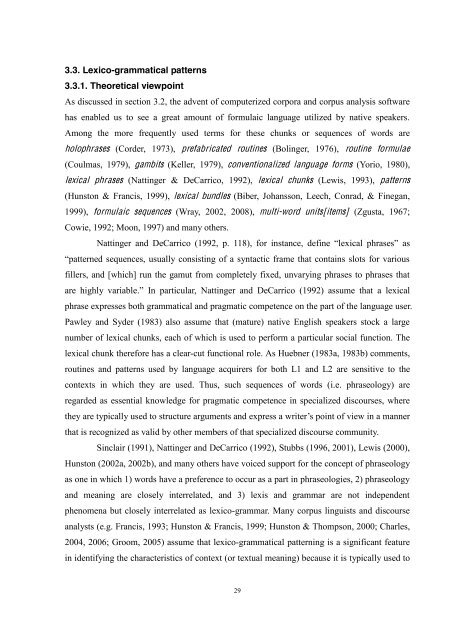Evaluative Meanings and Disciplinary Values - eTheses Repository ...
Evaluative Meanings and Disciplinary Values - eTheses Repository ...
Evaluative Meanings and Disciplinary Values - eTheses Repository ...
You also want an ePaper? Increase the reach of your titles
YUMPU automatically turns print PDFs into web optimized ePapers that Google loves.
3.3. Lexico-grammatical patterns<br />
3.3.1. Theoretical viewpoint<br />
As discussed in section 3.2, the advent of computerized corpora <strong>and</strong> corpus analysis software<br />
has enabled us to see a great amount of formulaic language utilized by native speakers.<br />
Among the more frequently used terms for these chunks or sequences of words are<br />
holophrases (Corder, 1973), prefabricated routines (Bolinger, 1976), routine formulae<br />
(Coulmas, 1979), gambits (Keller, 1979), conventionalized language forms (Yorio, 1980),<br />
lexical phrases (Nattinger & DeCarrico, 1992), lexical chunks (Lewis, 1993), patterns<br />
(Hunston & Francis, 1999), lexical bundles (Biber, Johansson, Leech, Conrad, & Finegan,<br />
1999), formulaic sequences (Wray, 2002, 2008), multi-word units[items] (Zgusta, 1967;<br />
Cowie, 1992; Moon, 1997) <strong>and</strong> many others.<br />
Nattinger <strong>and</strong> DeCarrico (1992, p. 118), for instance, lexical phrases <br />
patterned sequences, usually consisting of a syntactic frame that contains slots for various<br />
fillers, <strong>and</strong> [which] run the gamut from completely fixed, unvarying phrases to phrases that<br />
are highly variable In particular, Nattinger <strong>and</strong> DeCarrico (1992) assume that a lexical<br />
phrase expresses both grammatical <strong>and</strong> pragmatic competence on the part of the language user.<br />
Pawley <strong>and</strong> Syder (1983) also assume that (mature) native English speakers stock a large<br />
number of lexical chunks, each of which is used to perform a particular social function. The<br />
lexical chunk therefore has a clear-cut functional role. As Huebner (1983a, 1983b) comments,<br />
routines <strong>and</strong> patterns used by language acquirers for both L1 <strong>and</strong> L2 are sensitive to the<br />
contexts in which they are used. Thus, such sequences of words (i.e. phraseology) are<br />
regarded as essential knowledge for pragmatic competence in specialized discourses, where<br />
they are typically used to structure arguments <strong>and</strong> express a writers point of view in a manner<br />
that is recognized as valid by other members of that specialized discourse community.<br />
Sinclair (1991), Nattinger <strong>and</strong> DeCarrico (1992), Stubbs (1996, 2001), Lewis (2000),<br />
Hunston (2002a, 2002b), <strong>and</strong> many others have voiced support for the concept of phraseology<br />
as one in which 1) words have a preference to occur as a part in phraseologies, 2) phraseology<br />
<strong>and</strong> meaning are closely interrelated, <strong>and</strong> 3) lexis <strong>and</strong> grammar are not independent<br />
phenomena but closely interrelated as lexico-grammar. Many corpus linguists <strong>and</strong> discourse<br />
analysts (e.g. Francis, 1993; Hunston & Francis, 1999; Hunston & Thompson, 2000; Charles,<br />
2004, 2006; Groom, 2005) assume that lexico-grammatical patterning is a significant feature<br />
in identifying the characteristics of context (or textual meaning) because it is typically used to<br />
29
















